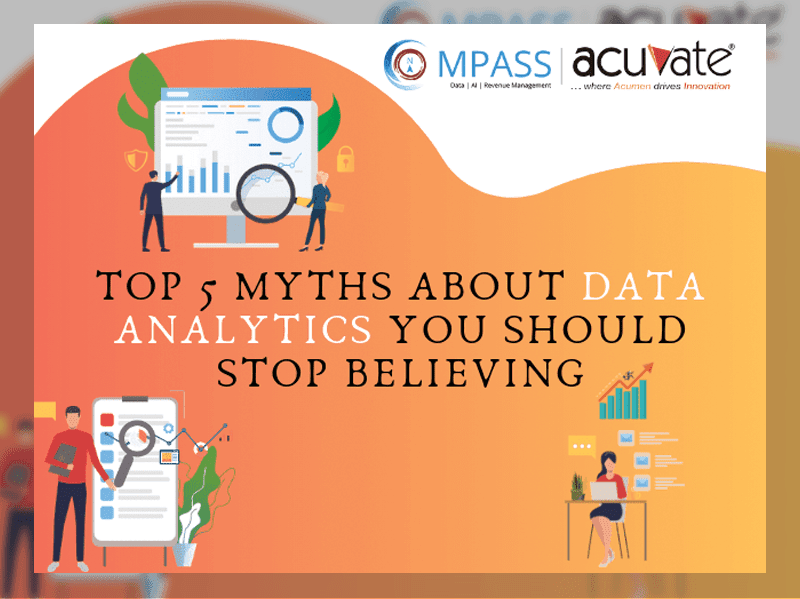Data Analytics in Business
According to Stastia, the global big data market is forecasted to grow to 103 billion U.S. dollars by 2027, more than double its expected market size in 2018. Implemented properly, analytics projects help in effectively capturing and analyzing data to glean insights to analyze how things functioned in the past, while at the same time predicting what business decisions to make in the future.
While data analytics helps companies make informed decisions and gain a competitive edge, misconceptions surrounding it can hamper its impact. If you are an organization set out to embrace data analytics, here’s a list of the top 5 myths you need to be aware of.
Myth 1: Only Large Companies With Big Data Need Data Analytics
Truth: If you are part of a small or midsize business (SMB), you may believe that data analytics is not for you. But you cannot be further from the truth. Irrespective of the size of an organization, big data analytics can be leveraged to better drive business growth. Analytical insights can help identify problem areas in a company while also providing an accurate idea of what the customer expectations are. This gives companies the much needed competitive advantage in the market. It is also believed that data analytics requires a large investment involving an IT team and data scientists (another myth that we will debunk going ahead), something SMBs are simply not equipped to handle. While SMBs may not be able to invest major dollars in hiring a team exclusively for data analytics, the fact that they are compact organizations with very few branches and business verticals makes it easy to apply business insights in order to streamline and improve processes quickly.
An added misconception is that data analytics is only feasible when dealing with enormous amounts of data, in other words ‘big data’. Okay, we know that data analytics gained traction with the arrival of big data, but there is no reason why it cannot be applied to smaller data sets as well. In fact, it is not the quantity but rather the quality of data that determines what kind of business insights are generated and whether or not they improve the decision-making process.
Myth 2: Data Analytics Is Extremely Expensive
Truth: When it comes to adopting new technology, one of the first questions asked is “How much will it cost?” The idea behind implementing a technological solution, such as data analytics, is to gain a tangible benefit from the project. And when we say tangible, we predominantly mean money. So if companies believe the myth that data analytics is a costly undertaking, chances are they will never invest in it. This is especially true in the case of small or midsize organizations.
But the truth is, not ALL data analytics endeavors require a major investment. The expense, in fact, is relative and depends upon the type of solution chosen by the company. And talking of gaining a tangible benefit, data analytics enable companies to make better-informed decisions, in turn maximizing the ROI.
Additionally, by making smarter infrastructure choices, companies can prevent data analytics costs from ballooning. One way to limit infrastructure cost is by using a public cloud platform to store data and run analytics. This limits storage and logistical costs usually incurred due to fragmented data storage units. Additionally, companies needn’t invest in name brand data analytics solutions from the get-go. In order to ‘test-drive’ analytical impact on business, organizations can opt for any one of the many open source tools available in the marketplace. By embracing modern, cloud-based systems and big data architecture, companies can avoid the large costs that traditional analytical infrastructure usually brings.
Myth 3: We Will Need Data Scientists And An IT Team To Handle The Analysis
Truth: Most companies mistakenly think that data analytics is an IT undertaking. While data analytics needs a certain degree of technical acumen, it is best handled by someone who has technical knowledge along with an idea of the company’s business goals. Additionally, hiring data scientists is a time as well as cost-intensive process as good resources tend to be in high demand. So companies can look at implementing Augmented Analytics instead. Augmented analytics helps relieve an organization’s dependence on data scientists or other manual tropes by automating the insight generation process with the help of advanced machine learning and artificial intelligence algorithms. What this essentially means is that an augmented analytics engine can automatically go through a company’s data, clean it, analyze it, and convert these insights into action steps for the decision makers with little to no supervision from a technical person.
According to Gartner, Augmented Analytics is an “approach that automates insights using machine learning and natural-language generation, marks the next wave of disruption in the data and analytics market.” Gartner also recommends data and analytics leaders to plan and adopt augmented analytics as platform capabilities mature. Augmented analytics can essentially cut down on constant human intervention in insights generation.
Myth 4: Algorithms Never Go Wrong
Truth: Most people are of the belief that algorithms are fail-safe, making them ignorant of how the technology actually works. While it is true that most algorithms are locked down following rigorous testing, it can be potentially disastrous to trust them implicitly. Instead, stakeholders must quiz the algorithm developers to understand how answers are reached. This will help maintain transparency in the process and will enable human agents to verify analytical results if required.
Myth 5: AI-Powered Data Analytics Will Eliminate The Need For A Human Workforce
Truth: This happens to be the MOST widely believed myth. The common misconception is that artificial intelligence will eliminate the need for people to perform certain tasks. While it is true that AI is powerful and can work in ways and with speeds which human beings can just not manage, it cannot completely replace the human workforce; at least, not right now.
While the majority of the human workforce treats AI as its competition, employees need to stop feeling threatened by AI and instead harness the technology to streamline their work. When it comes to data analytics, leveraging Augmented Intelligence is where the balance lies. Augmented intelligence is the use of AI to ‘enhance’ the human decision-making process. This fosters a collaborative culture between technology and the human workforce. With the help of augmented intelligence, employees can off-load repetitive, time-intensive analytical tasks and instead automate the process to glean valuable insights from data. While the augmented analytical technology will provide critical insights, it leaves the data interpretation itself to the human agent.
If you’d like to know more about the different data analytics myths or need some personalized guidance in your organizational analytics journey, feel free to get in touch with one of our data analytics experts for a quick consultation.



